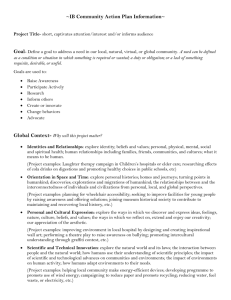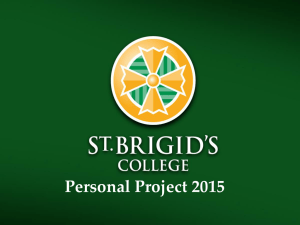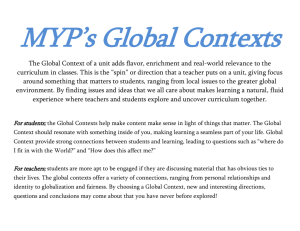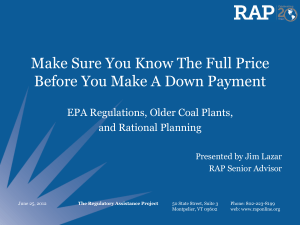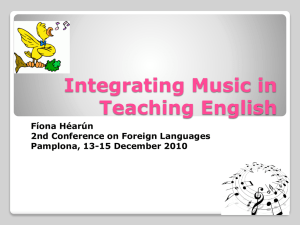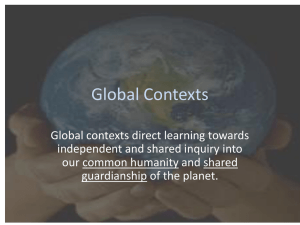Personal Project Presentation for students who will be 10th graders
advertisement
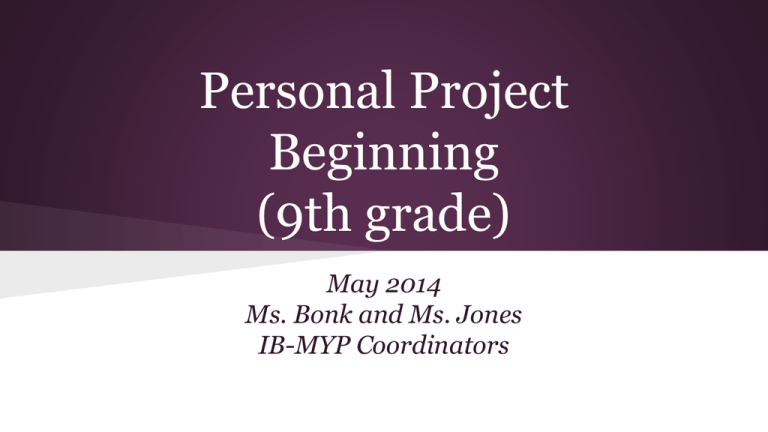
Personal Project Beginning (9th grade) May 2014 Ms. Bonk and Ms. Jones IB-MYP Coordinators Personal Project ● It provides an excellent opportunity for you, the student, to produce a truly personal and creative piece of work. ● The personal nature of the project important; the project should be based around a topic that motivates and interests you. Personal Project Requirements ● Process Journal ● Supervisor Check-In (three times) ● Outcome or Product ● Report with Bibliography ● Showcase ● Recognition Celebration Process Journal Is. . . ● started at the beginning and used throughout the process ● a place for planning ● a place for recording interactions with sources ● a place for storing useful information ● a means of exploring ideas ● a place for reflection at various stages ● devised by you to fit your needs ● used to produce your report Is Not. . . ● used on a daily basis (unless this is useful for you) ● written up after the process has been completed ● additional work on top of the project; it is part of and supports the project ● a diary with detailed writing about what was done ● a static document with only one format Personal Project Report The report is evaluated by: ● Your investigation (Criterion A) ● Your plan (Criterion B) ● Your action/Result (Criterion C) ● Your reflection (Criterion D) Personal Project Products Challenging ● A student creates a bag using a second-hand material. ● A student documents his or her self-taught skills of photography. Highly Challenging ● A student wants to create a range of bags using second-hand materials to exhibit at a local arts center. ● A student documents his or her neighborhood through a photography exhibition. Global Contexts You will choose one of the Global Contexts as a focus to your Personal Project. This has great impact on the Project as it defines your goal. ● ● ● ● ● ● Identities and relationships Orientation in space and time Personal and cultural expression Scientific and technical innovation Globalization and sustainability Fairness and development Global Context (rap as a music genre) Global Context Examples Identity and Relationships Examine the question, “Why does Rap speak to me?” Orientation in space and time Explore the development of rap as a style of music across the continents. Personal and cultural expression Perform a rap song for an audience and have a question-andanswer session. Identities and Relationships Definition: Students will explore identify; beliefs and values; personal, physical, mental, social and spiritual health; human relationships including families, friends, communities and cultures; what it means to be human. Examples: ● Two side of social networking; an awareness campaign about digital citizenship and cyber bullying ● How online identities impact offline relationships; a research essay ● Keeping culinary traditions; a video series following family recipes with historical relevance ● The effect of mass media on teenage identity; a short film Orientation of Space and Time Definition: Students will explore personal histories; homes and journeys; turning points in humankind; discoveries; explorations and migrations of humankind; the relationships and the interconnectedness of individuals and civilizations from personal, local and global perspectives. Examples: • The Euclidean space perspective of the universe; a 3D model • Charting a family history through archives and a representational statue • Explorers in search of a new world; immigration through visual texts Personal and Cultural Expression Definition: Students will explore the ways in which we discover and express ideas, feelings, nature, culture, beliefs and values; the ways in which we reflect on, extend and enjoy our creativity; our appreciation of the aesthetic. Examples: • The art of Manga in Japanese culture; a Japanese anime and a survey of the understanding of my peers • Culture and self-expression through dance at the local community arts centre; a performance Scientific and Technical Innovation Definition: Students will explore the natural world and its laws; the interaction between people and the natural world; how humans use their understanding of scientific principles; the impact of scientific and technological advances on communities and environments; the impact of environments on human activity; how humans adapt environments to their needs. Examples: • Nano fibers build stronger bikes; a prototype bike with nano fibres • Why are genetics and genomics important to my health?; a media presentation • Can stem cells replace organ transplants?; an investigative report Globalization and Sustainability Definition: Students will explore the interconnectedness of human-made systems and communities; the relationship between local and global processes; how local experiences mediate the global; the opportunities and tensions provided by worldinterconnectedness; the impact of decision- making on humankind and the environment. Examples: • The struggle for water in developing countries; an awareness campaign • Education as the tool to change the future of Peru; a workshop for adults • The role of the developing countries in protecting the tropical rain forest; a collection of slides Fairness and development Definition: Students will explore rights and responsibilities; the relationship between communities; sharing finite resources with other people and with other living things; access to equal opportunities; peace and conflict resolution. Examples: • Supporting fair trade: Cocoa trade in Ghana; an awareness campaign for our school restaurant/cafeteria to promote fair trade • Open-market economies and their role in fair trade; a talk for students • Exploring the intersections of race and inequality; a radio broadcast • Asylum seekers and their right to live like us; a painting “The difference between school and life? In school you’re taught a lesson and then given a test. In life you’re given a test that teaches you a lesson.” - Tom Bodett FAQ’s 1. Can I have a partner? Yes, as long as you and your partner have separate products. You might do a photography exhibit of your friend skateboarding. His project is to build a skateboard and your project is to create a photo exhibit of him skateboarding. 2. Do I get credit for the Personal Project? Yes. You receive 1 credit on your transcript as well as a ‘P’ for passing or an ‘N’ for not passing. FAQ’s (continued) 3. How can others help me with this project? Your teachers will guide you in the timeline and the requirements. You will need a supervisor to assist you in choosing the project, making sure that the project is challenging enough for you, checking-in along the way, and finalizing the project (minimum of three check-ins). You can also find a mentor who would be an expert in your personal project area. 4. What is the timeline for the Personal Project? You will want to start on your project over the summer. You will want to have your personal project complete by late Winter. This includes your report, your process journal, and your final product and outcome. QUESTIONS? IDEAS? thank you.

